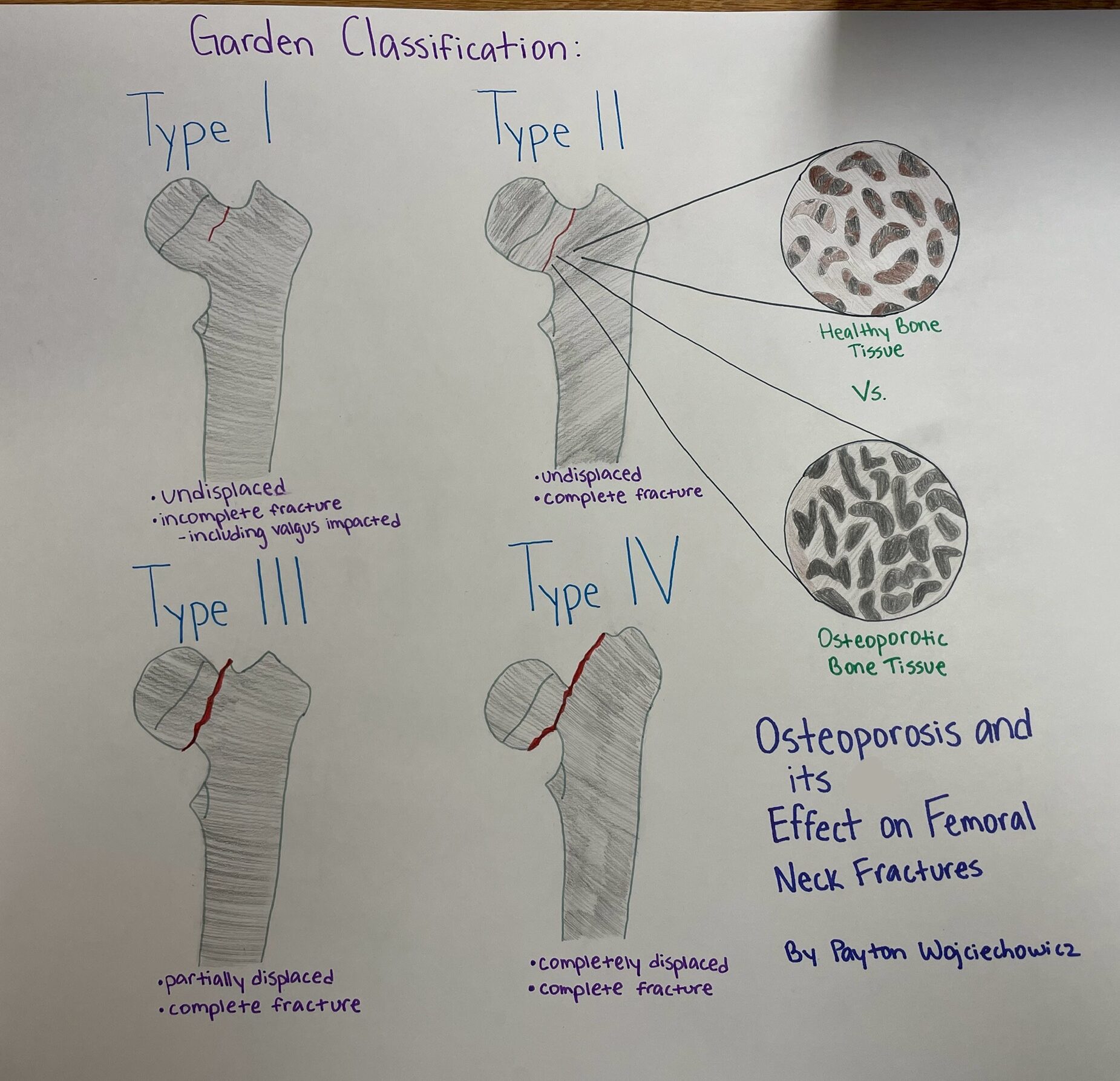
My STEAM project is on femoral neck fractures and how osteoporosis can affect the likelihood of them occurring through drawings. The two objectives I will be focusing on is to classify fractures and know the stages of bone development and repair. I drew out and explained the four types of femoral neck fractures that can occur shown through the Garden Classification: Type I, II, III, and IV. The identification of these fractures are dependent on the displacement of the bone and how completed the fracture is through the femoral neck (Kazley et al. 2018). Osteoporosis occurs when there is an imbalance in bone remodeling between osteoblasts (deposition of calcium to build bone) and osteoclasts (resorption of calcium to break down bone), so there is more breakdown of the bone than rebuilding. This causes the skeleton to have low bone mass and appear more porous compared to healthy bone tissue, thus causing instability and bone fragility (Metcalfe 2008). When looking at the right side of my drawing, there is a visible difference between healthy bone tissue in the femoral neck of the femur versus osteoporotic tissue. There are many factors that can increase the risk of developing osteoporosis; with the more common factors being age, because as humans get older they are more likely to develop this bone disease, sex, hormone levels, family history, dietary factors, for example low calcium or eating disorders (Mayo Clinic 2023). Hip fractures located in femoral necks experiencing osteoporosis are more prone because of the amount of stress that is inflicted on that one part of the femur and the change in structure of the bone as humans age. The femoral neck experiences a lot of compression and tension from supporting a great amount of body weight and many different movements from simple actions such as walking and bending over. So, when osteoporosis develops the loss of bone density can cause the bone tissue to break upon sudden force, thus causing different kinds of femoral neck fractures (Osterhoff et al. 2016).
References:
Kazley JM, Banerjee S, Abousayed MM, Rosenbaum AJ. Classifications in Brief: Garden Classification of Femoral Neck Fractures. Clin Orthop Relat Res. 2018 Feb;476(2):441-445. doi: 10.1007/s11999.0000000000000066.
Mayo Foundation for Medical Education and Research. (2023, September 7). Osteoporosis. Mayo Clinic. https://www.mayoclinic.org/diseases-conditions/osteoporosis/symptoms-causes/syc-20351968
Metcalfe D. The pathophysiology of osteoporotic hip fracture. Mcgill J Med. 2008 Jan;11(1):51-7.
Osterhoff G, Morgan EF, Shefelbine SJ, Karim L, McNamara LM, Augat P. Bone mechanical properties and changes with osteoporosis. Injury. 2016 Jun;47 Suppl 2(Suppl 2):S11-20. doi: 10.1016/S0020-1383(16)47003-8.

I was paired with Payton Wojciechowicz and her STEAM project talked about femoral neck fractures and how osteoporosis can affect the likelihood of them occurring. Her two course objectives she covered were to classify fractures and know the stages of bone development and repair. She drew out and explained the four different types of femoral neck fractures that can occur shown through the Garden Classification: Type I, II, III, and IV. The type of classification the femoral neck fracture would fall under depends on the displacement of the bone and how complete the fracture is through the femoral neck. In her drawing, Type I shows the femoral neck is undisplaced, an incomplete fracture, and the valgus is impacted. Type II shows the femoral neck is undisplaced and a complete fracture. Type III the femoral neck is partially displaced and a complete fracture. Type IV shows the femoral neck completely displaced and a complete fracture. Payton points out in her paper that when you are looking at the right side of her drawing, there is a visible difference between healthy bone tissue in the femoral neck of the femur versus tissue affected by osteoporosis as she drew out a close-up image of the two tissues. Osteoporosis occurs when there is an imbalance between osteoblasts and osteoclasts, because of the hyperactivity of osteoclasts in the bones the calcium is being reabsorbed faster than the osteoblasts can rebuild bone. When osteoporosis develops the loss of bone density can cause the bone tissue to break upon sudden force, causing different levels of femoral neck fractures depending on severity.